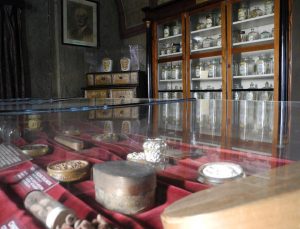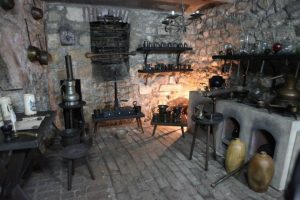One of the most interesting museums of Kolozsvár, Cluj-Napoca is the Pharmaceutical Museum, located on the north side of the Main Square of the city, in a building publicly known as the Mauksch-Hintz house. One of the greatest asset and attraction of this pharmaceutical history museum is the building itself, that continuously functioned as a pharmacy from the middle of the 18th century until 1949.
According to historical sources, the city’s oldest apothecary also functioned in this house in the 16th century. The rooms on ground floor are preserved to present their original functions: in the eastern wing the Officina – where medicines were actually sold, the storage rooms, and the laboratory, reconstructed in the basement. The museum also has a collection of hospital equipment as well, showing the different stages of medical development of the 20th century.
The first chambers of the house, with a corresponding vaulted cellar had been built at the beginning of the 16th century, and probably by the end of the century the construction of the first floor was finished as well. In the first half of the 18th century the house was bought by the Mauksch family, which had several pharmacists among its members. One of the renowned figures of the family, originated from the former Szepes (Zips) county of the Hungarian Kingdom was the chemist Tobias Mauksch, who was also caretaker of the Lutheran church.

In 1766 he had commissioned the restoration of the building and opened a public pharmacy.
That was when the beautiful paintings decorating the walls and vaults of the pharmacy’s office, the Officina and the seashell-shaped stucco-decoration of the representative ground-floor chamber in the north wing were finished. The allegorical paintings of the office are unparalleled in Transylvania: on the vaults we can see an allegorical depiction of the tree of life and the serpent of Aesculapius, as well as the depiction of a crane grasping pebbles between its claws, the symbol of precaution. An antique-styled inscription on the west wall of Officina in a rocaille-frame lists the names of all the pharmacists working here between 1573 and 1949.
The main façade, looking to nowadays’ Ferdinand street was reconstructed as well after 1766, and the pharmacy shop opened by Tobias Mauksch filled the entire width of it.
From the beginning of the 19th century the building became the property of the Szláby family. In 1851 it was inherited by the Hintz family (hence the name of the house: Mauksch-Hintz). At the end of the 19th century the main façade was redecorated again, the typically baroque architectural elements were removed, to give place for elements more characteristic to historicism.

The building continued to function as a pharmacy until its nationalization in 1949. In 1954, professor of medicine Valeriu Bologa,opened a pharmacy museum in a few rooms of the house. The exhibited material of the museum is actually the collection of a famous professor of medicine from the first half of the 20th century, Gyula Orient (1869–1940). His collection has been donated to the Transylvanian Museum Association (Erdélyi Múzeum-Egyesület), and after the Communist regime disbanded the association, it was merged into the collection of the History Museum founded in 1963.
The owner of the Mauksch-Hintz house is a descendant of the Hintz family, dr. Georg Hintz, the main tenant being the Transylvanian History Museum. A few days ago the owner and tenant announced in a joint statement that the general restoration of the building had begun. The renovation works will last two years and the museum is scheduled tol reopen in 2020.
Title image: Weberbau.ro
Interior images: Pharmacy Museum